Henry Ford once said, “a customer can have a car painted any color he wants as long as it’s black”? There were several reasons why that was, but still, there wasn’t much of a choice. The was true when representing a stack or a vent in AERMOD. Whether the vent exhausted vertically, horizontally, or radially (as when it is capped), there was only a POINT source options. The user had to come up with an effective diameter (0.001 meters) and velocity (0.001 meters per second) to account for any non-vertical flow.
Last year, EPA made regulatory the use of two new source types: POINTCAP and POINTHOR, to better represent capped and horizontal venting stacks, respectively. With these two new options, it raises the question of how would modeling results differ between choosing one of these source types and using the pseudo-POINT representation? In this article, we look at trying to provide you with an answer to that question.
Analysis Approach
The most notable difference between using the POINT source type and POINTCAP or POINTHOR is the user enters the source parameter values (height, temperature, exit velocity, and exit diameter) identical to those of a vertically exhausting stack. No need for effective velocities or diameters to account for no vertical momentum and downwash effects. However, is there a difference in the modeling results?
To answer the question “what’s the difference?”, we modeled three sources; one POINT, one POINTCAP, and one POINTHOR, all located at the same location, with equivalent source parameters. The POINTCAP and POINTHOR sources were represented with typical non-zero values for velocity and diameter. The POINT source was represented with the typical pseudo-POINT effective values of 0.001 meters per second and 0.001 meters.
We considered the impact of buoyancy (ambient exit temperature and high temperature exhaust) and the influence of downwash (with and without a building near the source). The metric used to compare the results we are calling the factional difference, which is, for the capped stack case, [POINTCAP(result) – POINT(result)]/POINT(result). This metric was used because we not only want to know that there is a difference in the results, but how big is the relative difference, e.g. twice as big (2) or half as big (-0.5)). The closer the fractional difference is to zero, the less of a difference between the results.
The factional difference value was calculated at each receptor point for each hour, so the conditions for each POINT, POINTCAP, and POINTHOR result were identical.
The specifications for the modeling analysis are listed below.
Modeling scenario:
- Modeling domain
- 1 km X 1 km receptor grid
- Property 100 m X 100 m
- Sources
- 10 m source height
- 0.33 m diameter
- 10 m/sec velocity
- Ambient temperature OR 500 K (440 ˚F)
- Building
- 10 m X 10 m
- 9 m high
- Downwash and no-downwash scenarios
- Ambient and high temperature scenarios
- Model runs
- RUN_01: NO DOWNWASH, AMBIENT
- RUN_02: NO DOWNWASH, HIGH TEMP
- RUN_03: DOWNWASH, AMBIENT
- RUN_04: DOWNWASH, HIGH TEMP
- Results comparison
- (POINTCAP – POINT)/POINT
- (POINTHOR – POINT)/POINT
- For each hour and receptor
Case 1 – No Downwash and Ambient Temperature
POINTCAP analysis: the POINTCAP source representation will generally produce slightly higher predicted concentrations than the POINT representation, between about 15 to almost 40% higher, with the higher concentrations being closer to the source. There may be instances when the POINTCAP representation may produce lower predicted concentration values, but in most instances, the predicted concentrations will be higher.
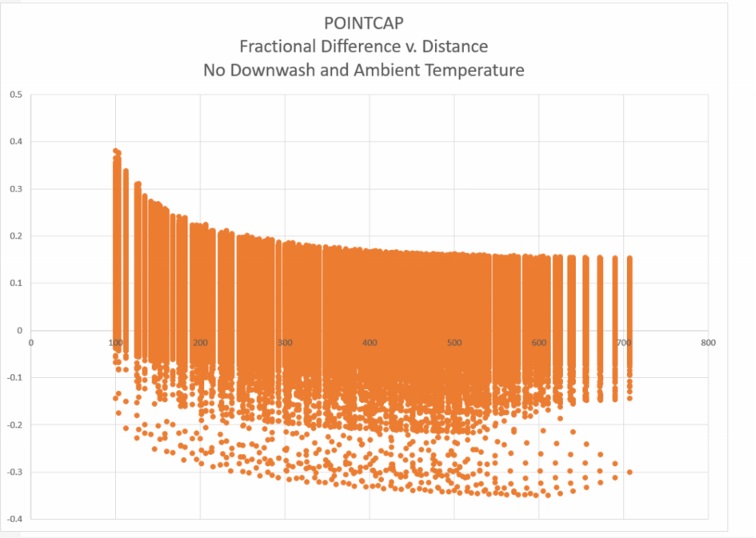
POINTHOR analysis: the POINTHOR source representation will generally produce lower predicted concentrations than the POINT representation, but the differences are extremely small, about 1%. The difference are even smaller with greater distance between the source and receptor.
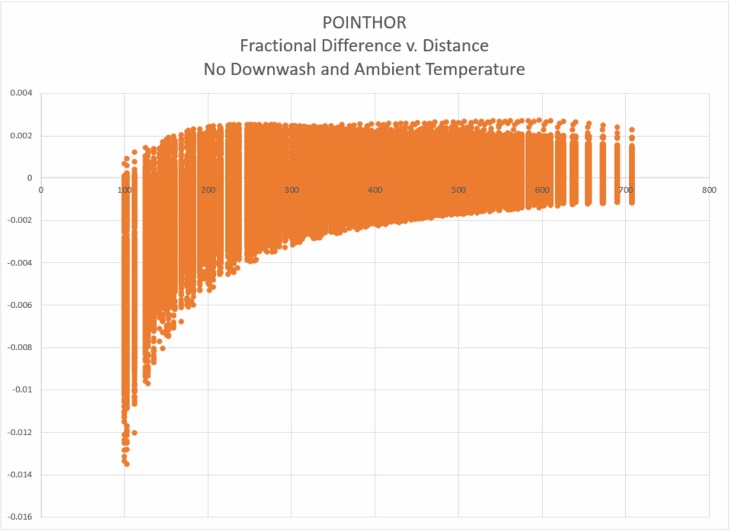
Case 2 – No Downwash and High Temperature
POINTCAP analysis: the POINTCAP source representation will generally produce higher predicted concentrations than the POINT representation. With factional difference values approaching -1, the predicted concentrations with the POINTCAP representation are generally much less than with the POINT representation. There may be instances when the POINTCAP will produce higher predicted concentrations than POINT, up to 25% at greater distances, but generally, the values using POINTCAP will be less.
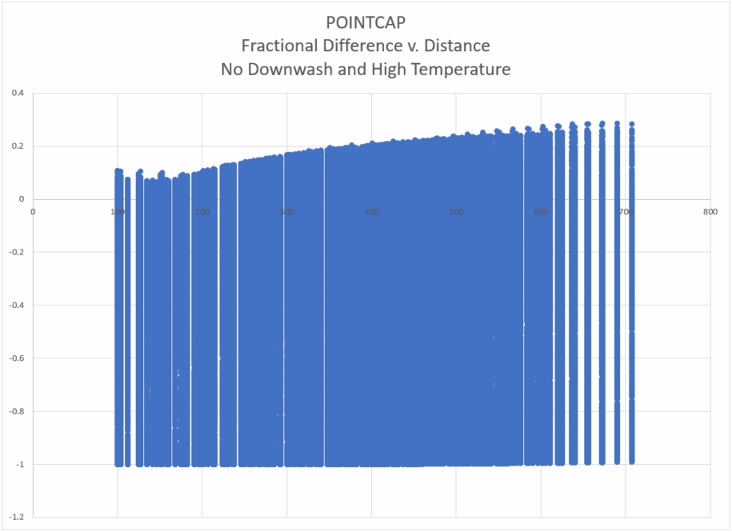
POINTHOR analysis: the POINTHOR source representation will generally produce higher predicted concentrations than the POINT representation. With factional difference values approaching -1, the predicted concentrations with the POINTHOR representation are generally much less than with the POINT representation. There may be instances when the POINTHOR will produce higher predicted concentrations than POINT, up to 25% at greater distances, but generally, the values using POINTHOR will be less.
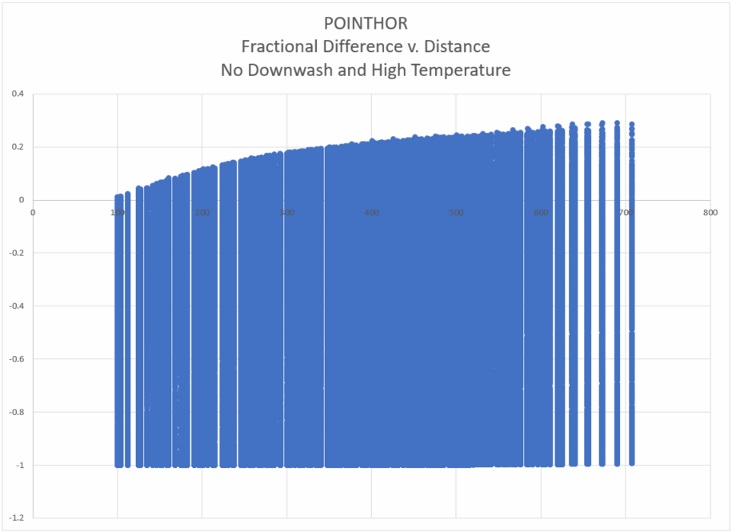
Case 3 – Downwash and Ambient Temperature
POINTCAP analysis: the POINTCAP source representation will generally produce slightly higher predicted concentrations than the POINT representation, between about 15 to almost 40% higher, with the higher concentrations being closer to the source. There may be instances when the POINTCAP representation may produce lower predicted concentration values, but in most instances, the predicted concentrations will be higher.
The comparison is nearly identical to the non-downwash ambient temperature case.
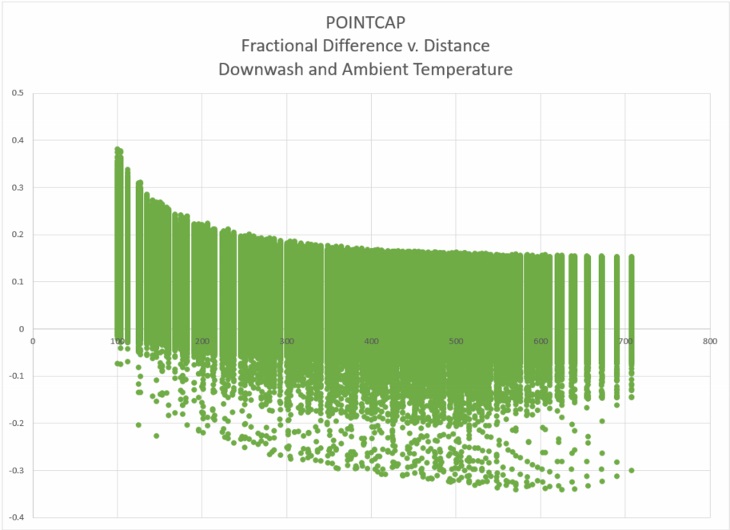
POINTHOR analysis: the POINTHOR source representation will generally produce lower predicted concentrations than the POINT representation, but the differences are extremely small, about 1%. The difference are even smaller with greater distance between the source and receptor.
Though the pattern of the data comparison is different, however the overall effect is the same whether there is downwash or no downwash when there are no buoyancy effects.
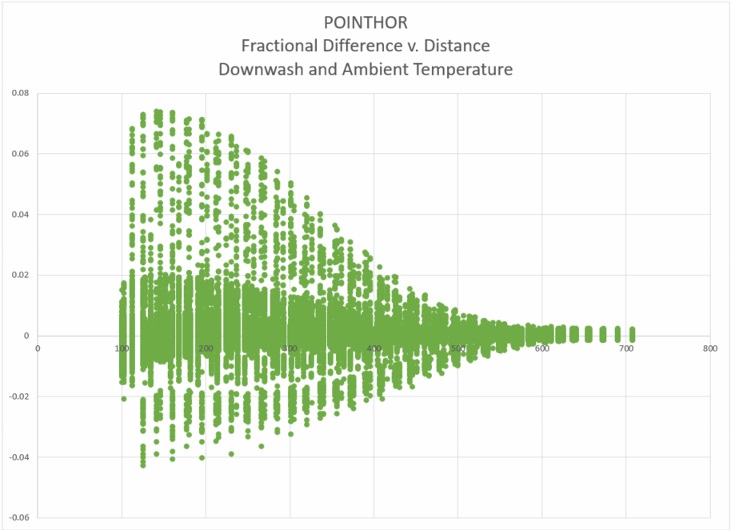
Case 4 – Downwash and High Temperature
POINTCAP analysis: the POINTCAP source representation will generally produce higher predicted concentrations than the POINT representation. With factional difference values approaching -1, the predicted concentrations with the POINTCAP representation are generally much less than with the POINT representation. There may be instances when the POINTCAP will produce higher predicted concentrations than POINT, up to 25% at greater distances, but generally, the values using POINTCAP will be less.
The pattern of the data comparison is more pronounced with downwash having an impact. Nearer the source, most likely due to downwash effects, the POINTCAP may produce higher predicted concentrations than POINT, but generally, the values using POINTCAP will be less. The influence of downwash dies out with distance.
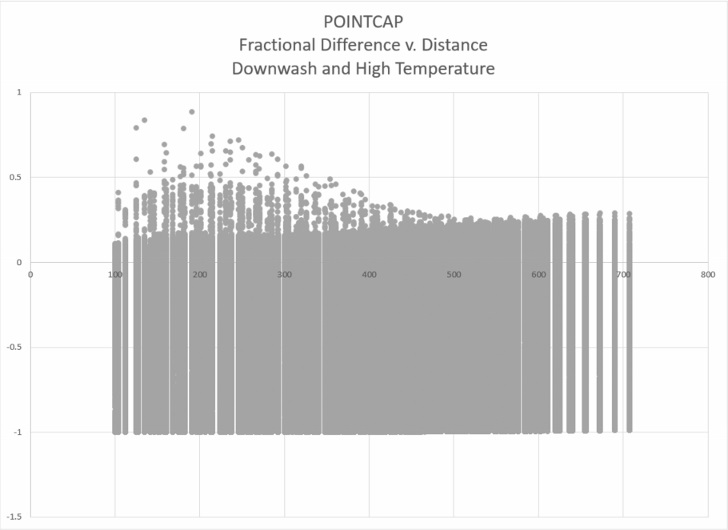
POINTHOR analysis: the POINTHOR source representation will generally produce higher predicted concentrations than the POINT representation. With factional difference values approaching -1, the predicted concentrations with the POINTHOR representation are generally much less than with the POINT representation. There may be instances when the POINTCAP will produce higher predicted concentrations than POINT, up to 25% at greater distances, but generally, the values using POINTHOR will be less.
The pattern of the data comparison is more pronounced with downwash having an impact. Nearer the source, most likely due to downwash effects, the POINTHOR may produce higher predicted concentrations than POINT, but generally, the values using POINTHOR will be less. The influence of downwash dies out with distance.
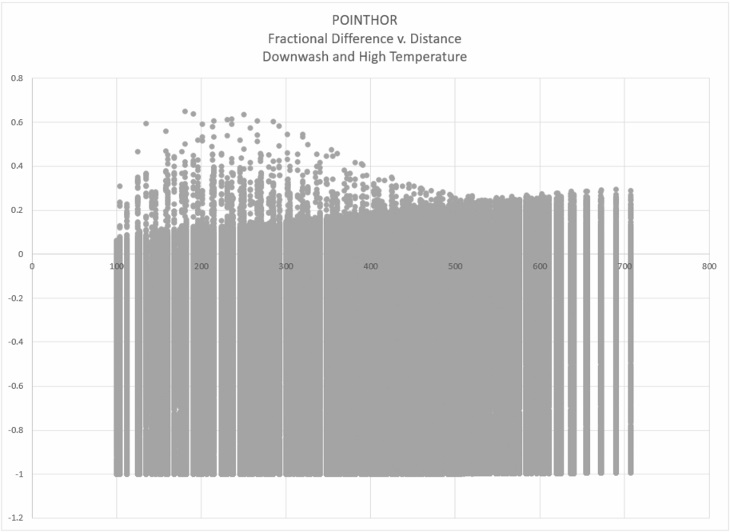
Summary
From looking at the analysis performed, if you are wanting to represent a horizontal vent that exhausts at ambient temperature, whether you use POINT or POINTHOR, the result will be about the same. If you project includes capped stacks that exhaust at ambient temperature, if you use POINTCAP to represent these sources, the result will generally be a higher predicted concentration than if you used the pseudo-POINT representation.
Whether you have a horizontal vent or capped stacks and your exhaust is hotter than the ambient temperature, both POINTCAP and POINTHOR will generally produce lower predicted concentrations than the pseudo-POINT representation.
Though the analysis performed does provide some useful information, it does not provide a complete picture. There are a few items that would fill in some of the information gaps, such as which weather conditions produce larger or smaller differences between the source representations.
If you found this article informative, there is more helpful and actionable information for you. Go to http://learn.naviknow.com to see a list of past webinar mini-courses. Every Wednesday (Webinar Wednesday), NaviKnow is offering FREE webinar mini-courses on topics related to air quality dispersion modeling and air quality permitting. If you want to be on our email list, drop me a line at ceo@naviknow.com.
One of the goals of NaviKnow is to create an air quality professional community to share ideas and helpful hints like those covered in this article. So if you found this article helpful, please share with a colleague.
